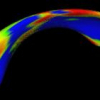Free Online Productivity Tools
i2Speak
i2Symbol
i2OCR
iTex2Img
iWeb2Print
iWeb2Shot
i2Type
iPdf2Split
iPdf2Merge
i2Bopomofo
i2Arabic
i2Style
i2Image
i2PDF
iLatex2Rtf
Sci2ools
ISBI
2004
IEEE
2004
IEEE
Statistical Surface-Based Morphometry Using a Non-Parametric Approach
We present a novel method of statistical surface-based morphometry based on the use of non-parametric permutation tests. In order to evaluate morphologicaldifferences of brain structures, we compare anatomical structures acquired at different times and/or from different subjects. Registration to a common coordinate system establishes corresponding locations and the differences between such locations are modeled as a displacement vector field (DVF). The analysis of DVFs involves testing thousands of hypothesis for signs of statistically significant effects. We randomly permute the surface data among two groups to determine thresholds that control the familywise (type 1) error rate. These thresholds are based on the maximum distribution of the amplitude of the vector fields, which implicitly accounts for spatial correlation of the fields. We propose two normalization schemes for achieving uniform spatial sensitivity. We demonstrate their application in a shape similarity study of the la...
Displacement Vector Field | ISBI 2004 | Medical Imaging | Non-parametric Permutation Tests | Uniform Spatial Sensitivity |
| Added | 20 Nov 2009 |
| Updated | 20 Nov 2009 |
| Type | Conference |
| Year | 2004 |
| Where | ISBI |
| Authors | Dimitrios Pantazis, Richard M. Leahy, Thomas E. Nichols, Martin Styner |
Comments (0)

